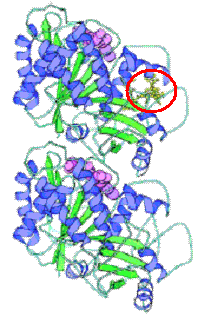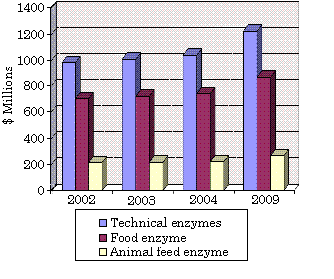New biocontrol method to manage mycotoxins in Africa
01.aug.07 Via Agnet
Cross posting
Consultative Group on International Agricultural Research
Ranajit Bandyopadhyay
Scientists at the International Institute of Tropical Agriculture (IITA) have developed a safe and effective method for biological control of aflatoxins. These are toxic chemicals of fungal origin, which contaminate maize and other major food crops, posing a chronic threat to human health in sub-Saharan Africa.
With the new method, strains of the fungi that produce aflatoxin are overwhelmed through the introduction of related but entirely harmless strains. These were identified and tested through several years of meticulous research supported by the German Agency for Technical Cooperation (GTZ) and carried out in collaboration with the Agriculture Research Service of the US Department of Agriculture, University of Arizona in the USA, University of Bonn in Germany and University of Ibadan in Nigeria.
Researchers found that inoculum containing the beneficial strains can be produced most efficiently on sorghum grain, resulting in a dry formulation, which can then be broadcast on moist soil in farmers’ maize fields. Laboratory and field tests have demonstrated that the harmless strains spread quickly from the soil to maize plants, where they reduce aflatoxin-producing strains on maize grain by 91 to almost 100 percent. A single application is sufficient to control the problem in the crop treated, though a few additional applications may be required to achieve long-term control in farmers´ fields. Large-scale testing of the new method is currently under way in Nigeria.
An insidious threat
Aflatoxins are produced by various fungi, such as Apergillus flavus and A. parasiticus, which grow as molds on staple grains and root crops both before harvest and in storage. Contamination of maize causes particular concern, because it is sub-Saharan Africa’s most important cereal.
The toxins are especially damaging to children. Continuous exposure has been shown to stunt growth and even contribute to infant mortality when coinciding with kwashiorkor, a form of malnutrition caused by dietary deficiency of protein and other nutrients. The insidious combination of impaired development and undernourishment accounts for about half of the 4.5 million deaths of children under the age of 5 occurring annually in sub-Saharan Africa.
Aflatoxins are also believed to affect the human immune system, making people more vulnerable to infectious diseases, such as malaria and HIV/AIDS. In addition, the toxins are linked to liver disorders and can act in synergy with the Hepatitis B virus to cause hepatocellular carcinoma. This is the most common cancer in sub-Saharan Africa, accounting for as many as 10 percent of adult male deaths in parts of West Africa.
Aflatoxins further damage the well-being of Africa’s rural families by limiting exports of maize and groundnut in particular. Grain-importing countries maintain high food quality standards, with especially strict controls on aflatoxin content. African food and feed products showing levels of contamination above the acceptable limits cannot penetrate major grain markets, resulting in significant loss of agricultural income.
Except when people die of acute poisoning, as happened in Kenya during 2004-2006, aflatoxins seldom receive adequate attention in the region, even though they clearly have serious consequences and are quite widespread. In Benin and Togo, for example, researchers found that aflatoxin levels are about five times the safe limit of 20 parts per billion in up to 30 percent of household grain stores. According to other results from a study carried out in those countries and Nigeria, 99 percent of blood samples collected randomly from children contained aflatoxins.
In pursuit of a biocontrol strategy
In an effort to reduce aflatoxin contamination, researchers at IITA and elsewhere have deployed various methods, involving, for example, modifications in grain drying, storage and food preparation practices. To complement strategies that have already proved effective, scientists have also actively pursued in recent years the option of biological control, building on the Institute’s long and extraordinary record of success in using this approach to combat major pests such as the mango and cassava mealybugs, cassava green mite, desert locust and banana nematodes and weevils.
The biocontrol strategy that appears to be effective against aflatoxin employs a mechanism that researchers refer to as “competitive exclusion.” This is made possible by the presence in nature A. flavus populations, not only of “toxigenic” strains, which produce copious amounts of aflatoxin, but also “atoxigenic” strains, which lack this capacity. In order for the strategy to work, researchers must identify and successfully introduce harmless strains that show a large competitive advantage over the dangerous ones.
In the resulting biological struggle, explains IITA plant pathologist Ranajit Bandyopadhyay, “the good strains of A. flavus virtually eliminate their highly toxic relatives and ensure that the ‘bad guys’ cannot re-emerge.”
Such a strategy has proved effective for controlling aflatoxin on cottonseed, groundnut and maize in the USA and on groundnut in Australia.
The challenge for scientists at IITA was to identify entirely safe atoxigenic strains of A. flavus that are indigenous to Africa and serve effectively as biocontrol agents. For this purpose, they first collected more than 4,200 samples of the fungus from different ecological zones of Nigeria. In these they identified 2,127 distinct strains, of which 1,000 proved to be atoxigenic. Only 26, though, were selected for further testing.
This involved an extremely laborious series of procedures, one of them, for example, involving.more than 30,000 crosses between different strains. The purpose was to group the selected strains according to “vegetative compatibility” and make sure they belong to groups consisting only of atoxigenic strains that cannot cross with toxigenic strains in nature. This procedure ensured that release of the biocontrol agents in the field would be absolutely safe, leading to a drastic reduction, rather than an inadvertent boost, in aflatoxin levels.
Proven effectiveness
From the 14 unique atoxigenic groups identified, one strain each from eight groups was chosen for further evaluation for ability to compete with toxigenic strains. When maize grains were inoculated in the laboratory and field with both a highly toxigenic A. flavus strain as well as atoxigenic strains, one of the latter reduced aflatoxin levels by 91 percent and two others by nearly100 percent.
In experimental field plots, various atoxigenic strains proved capable of spreading quickly from the soil on which they were released to maize plants. One especially promising strain was found on nearly 99 percent of the maize grains analyzed.
The eight promising strains were further screened for their ability to get established rapidly after release, continue spreading and survive in plant debris. Strains showing these abilities can achieve effective biocontrol of aflatoxin-producing strains over multiple years, with only a few additional applications after initial release.
Having identified several excellent candidate strains to serve as agents of biocontrol, IITA researchers are further testing these in large-scale trials at various locations in Nigeria. To permit wide release of these biocontrol agents in the fields, researchers have developed safe, efficient and effective methods for producing and applying inoculum. IITA now seeks further support to disseminate the biocontrol technology as part of a “basket” of simple aflatoxin management practices that can reduce aflatoxin levels in Africa’s food and improve the health of its people.
Labels: Discovery, Food biotechnology, Innovation







